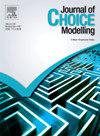Recursive logit models for dynamic versus sequential trip chaining
IF 2.4
3区 经济学
Q1 ECONOMICS
引用次数: 0
Abstract
This paper applies recursive logit (RL) to model activity-trip chaining behaviour. We present a comparison between two approaches to applying the RL model in this context. In the first ‘sequential’ approach, agents form a trip chain by making a sequence of joint choices of activity location (i.e. trip destination) and travel mode, ending the chain by choosing to return home. The second ‘dynamic’ approach adds a time variable. Its agents form a full-day activity/travel schedule by making a sequence of choices either to continue the current activity for a fixed timestep or make a joint choice of new activity location and travel mode. We estimate parameters for both models using data from a Stockholm travel survey and validate model simulations against observed data. The models reproduce patterns of observed behaviour beyond their estimated parameters, including different types of trip chains and the spatial distribution of activities. While the dynamic model is advantageous in its ability to predict agent schedules, reflect time-varying travel conditions and endogenously represent space–time constraints, it does not surpass the simpler sequential model on mutual areas of trip chaining behaviour. We conclude that the RL model is well-suited to model trip chaining behaviour, and that the simpler sequential approach may be appropriate for many modelling purposes.
动态与顺序行程链的递归逻辑模型
本文应用递归逻辑(RL)对活动-行程链行为进行建模。我们提出了在这种情况下应用RL模型的两种方法之间的比较。在第一个“顺序”方法中,agent通过一系列共同选择活动地点(即旅行目的地)和旅行方式形成一个旅行链,并以选择回家结束该链。第二种“动态”方法增加了一个时间变量。它的代理通过做出一系列选择,或者在固定的时间步继续当前的活动,或者联合选择新的活动地点和旅行方式,形成全天的活动/旅行计划。我们使用来自斯德哥尔摩旅行调查的数据估计两个模型的参数,并根据观测数据验证模型模拟。这些模型再现了超出其估计参数的观测行为模式,包括不同类型的行程链和活动的空间分布。虽然动态模型在预测agent调度、反映时变旅行条件和内生表示时空约束方面具有优势,但在行程链行为的相互区域上,它并没有超越简单的序列模型。我们得出结论,RL模型非常适合模拟行程链行为,并且更简单的顺序方法可能适用于许多建模目的。
本文章由计算机程序翻译,如有差异,请以英文原文为准。
求助全文
约1分钟内获得全文
求助全文

 求助内容:
求助内容: 应助结果提醒方式:
应助结果提醒方式:


